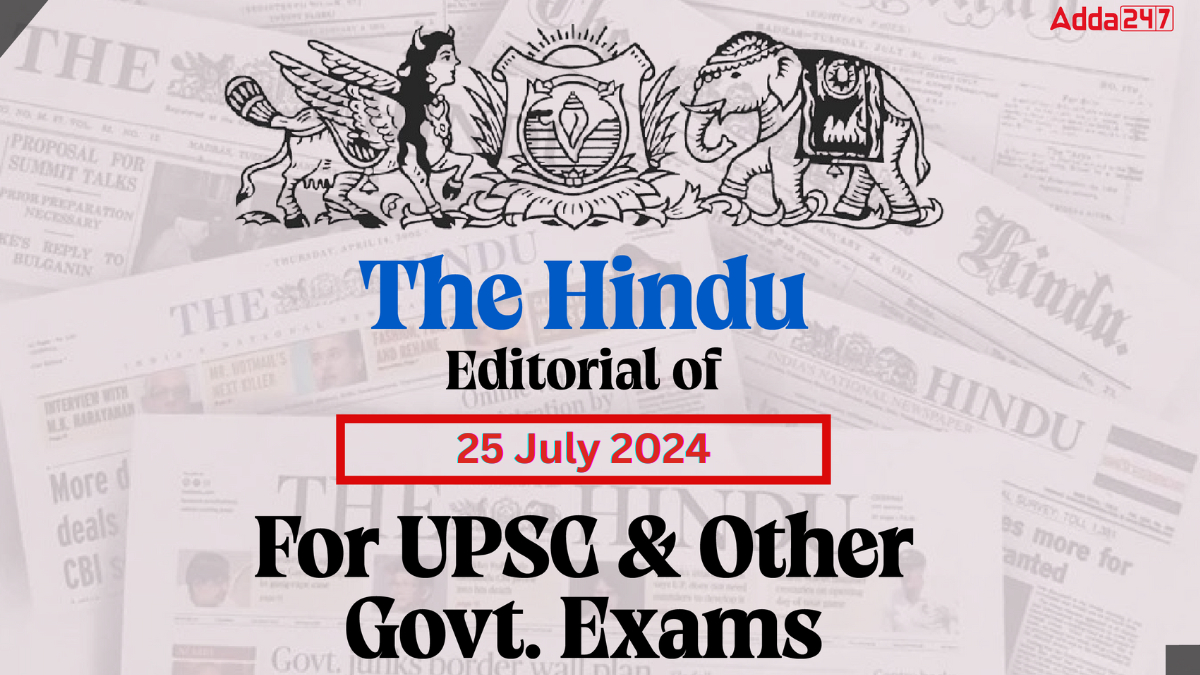Editorial 1:Budget 2024 — long on intent, short on details
The Union Budget 2024, presented by the Finance Minister, stands out for its clear articulation on three main aspects. First, it lays down the vision for Vikisit Bharat@2047 through nine priority areas, indicating a long-term strategy that future Budgets are expected to follow. Second, it explicitly acknowledges the issue of unemployment, dedicating significant space to initiatives aimed at job creation. Third, the influence of coalition government dynamics is subtly present, guiding the Budget’s strategy and approach. While the intentions are commendable, the lack of detailed execution plans casts doubt on the feasibility of achieving these ambitious goals.
Continuity in Fiscal Policy
- Fiscal Consolidation Efforts: The Budget signals continuity in fiscal consolidation efforts, lowering the overall fiscal deficit to 4.9% from the interim target of 5.1%. A substantial portion of the surplus from the Reserve Bank of India has been allocated to fiscal prudence. The goal of reducing the fiscal deficit to below 4.5% of GDP by FY2026 is reiterated, linking the medium-term fiscal consolidation path to a reduction in the debt/GDP ratio rather than just compressing the fiscal deficit/GDP ratio. This shift allows for greater flexibility in fiscal policy, enabling higher capital spending and support for climate goals in a volatile global environment.
- Budget Size and Borrowing: The Budget size has increased marginally, and the overall borrowing program remains almost unchanged, with a slight reduction. This stability reflects a conservative fiscal approach despite buoyant revenue collections.
Expenditure Trends
Capital Expenditure: Despite a slight increase in overall expenditure, capital expenditure remains largely unchanged. Two concerning trends are observed:
- The Budget estimates for 2024-25 show only marginal increases in most expenditure items compared to 2023-24, with some key areas like commerce, industry, and energy experiencing declines.
- Revised estimates for 2023-24 are lower than the initial Budget estimates for the same year, indicating potential underutilization of funds.
Effective Capital Expenditure: The decline in effective capital expenditure suggests challenges in the government’s spending capacity, potentially undermining the expected multiplier effects. The reliance on private investments for economic growth, as highlighted in the Economic Survey, remains a concern given the recent lack of significant increases.
Stimulating Demand and Employment
- Measures to Bolster Demand: The Budget aims to stimulate demand through adjustments to the new income-tax regime, providing slightly more disposable income for some taxpayers. However, this measure falls short of significantly boosting demand and household savings.
- Employment Initiatives: Employment growth is expected through various initiatives, including an internship scheme and incentives for companies to hire first-time employees. However, these schemes face challenges in addressing social aspirations and technological changes affecting the labor market. The risk of the internship scheme becoming a short-term urban employment program, creating a future pool of unemployed individuals, is a concern.
- MSME Sector Revival: The revival of the Micro, Small, and Medium Enterprises (MSME) sector through credit guarantees and non-collateralized lending models is expected to boost employment. However, MSMEs require a conducive operational environment, and merely providing credit may not yield the desired results.
Key Omissions and Concerns
- Industrial Sector: The Budget lacks significant measures for the industrial sector, with no mention of the Railways, Production Linked Incentive (PLI) Scheme, Gati Shakti, and the Census.
- Education and Health: The absence of clear initiatives in the education and health sectors, crucial for leveraging the demographic dividend, is a missed opportunity.
- Balancing Urban and Rural Development: Balancing urban and rural development and distinguishing between jobs and internships are critical for holistic economic growth. The Budget could have provided more detailed plans for achieving the vision of 2047.
Conclusion
The Union Budget 2024 sets a visionary path for a developed India by 2047 and addresses key issues like unemployment and fiscal consolidation. However, the lack of detailed execution plans raises questions about the feasibility of achieving these ambitious goals. While the intentions are commendable, robust strategies and effective implementation are essential to realize the Budget’s full potential.



 Why India-Pakistan Partition Needed?
Why India-Pakistan Partition Needed?
 Today The Hindu Editorial of 1 August 20...
Today The Hindu Editorial of 1 August 20...
 The Hindu Editorial Today 31 July 2024, ...
The Hindu Editorial Today 31 July 2024, ...







